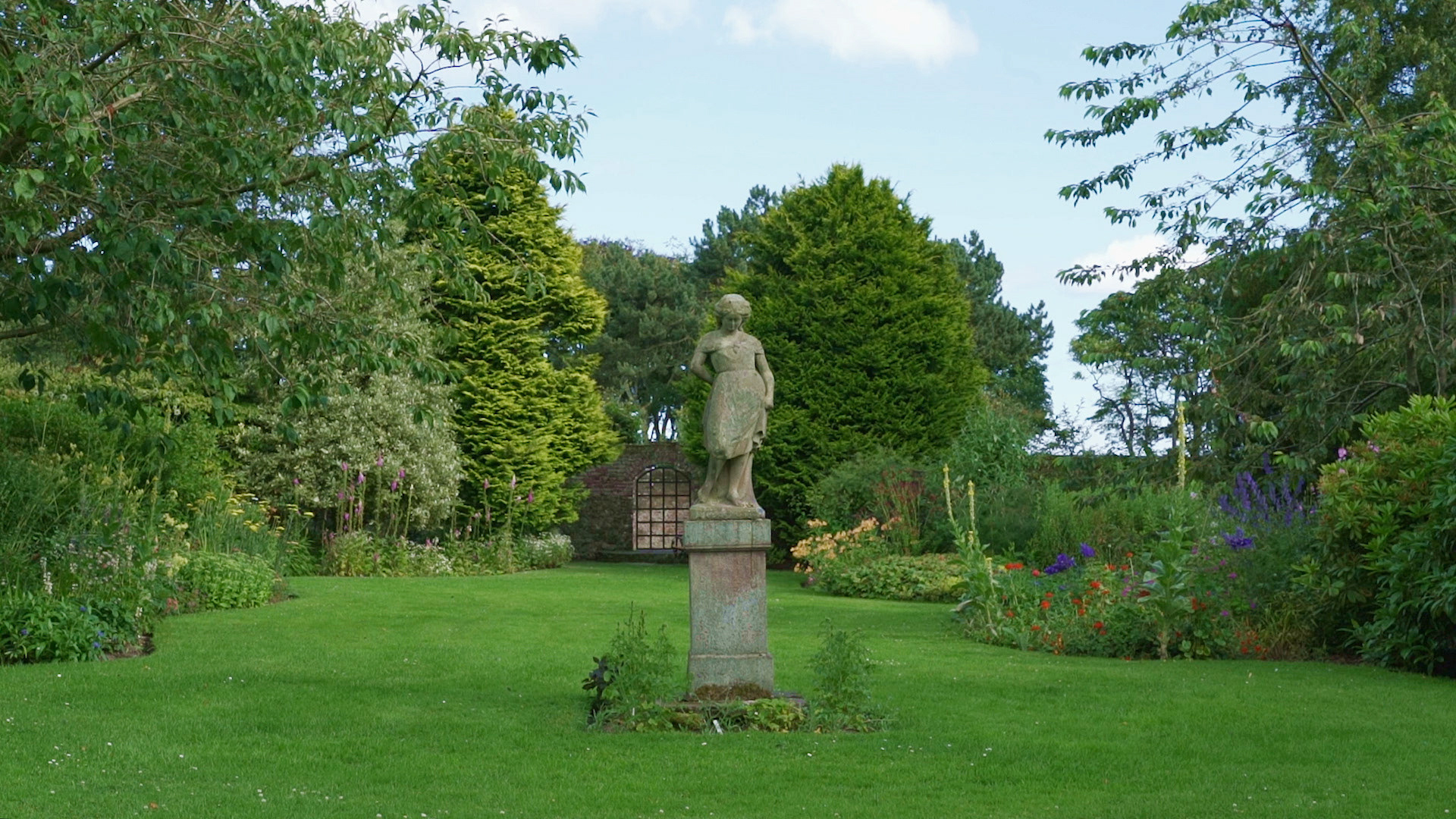On my way into writing about Ellie Kyungran Heo’s human and nonhuman filmic assemblages,[1] I encountered a philosopher who said:
‘[1.] the stone (material object) is worldless; [2.] the animal is poor in world; [3.] man is world-forming’.[2]
For Heidegger, and he is not alone in this, ‘world-forming’ rests on access to speech, logos, and conscious knowledge of the finitude of life and the infinitude of Being. Both this knowledge and use of language enable Man, or the human, to project desire beyond mere existence. Animals, and by inference, plants, are simply captivated by, or held captive within, the world. They do not project, only absorb, plants falling further out of the equation because, unlike animals, they do not roam about, or have stomachs. While animals do not speak, they can cry out in pain, or in anticipation of being fed, whereas plants, at least to human ears, are silent. Sessile and mute, they only become animated in being culled or plucked from the ground, their animation dependent on human intervention.
Ellie Kyungran Heo’s films put paid to this vision of world-forming. In her films, humans and nonhumans together assemble worlds of intersecting coexistences, adaptive admixtures that oscillate between intimacy and conflict, damage and care. Words are rarely used and when they are, they emerge as minor players in her diverse ecological soundscapes. The Plantarians series, 2017-2020, capitalizes on film’s essential capacity to imbue all things with a pulsating liveliness regardless of whether they appear not to move or have a heartbeat. In the series’ four-channel video installation, plants do get plucked, cooked, and eaten, but the work’s four episodes carefully attends to how these disruptions participate in an expansive mesh of life cycles involving nutrition and compost, as well as feelings of sadness, solace and joy. As Anna L. Tsing writes: ‘using others as part of a life world – for example, in eating and being eaten’ is quite different from isolating things as mobile assets to be exchanged purely for monetary value.[3] Filmed on three sites – an English-style garden in Hospitalfield, Scotland; a garden and a cemetery in Maastricht; and a plot of earth in Central Park, New York – the particularities of these geo-locations proffer diverse worldings that sing of vegetal abundance, one that is both nurturing and in need of nurture, the latter often in conjunction with a careful kind of violence. ‘When people don’t use the plants, they get scarce. You must use them so that they will come up again’.[4]
The first episode nose-dives into a tangled mass of plant life, the weeds being deftly and frenetically culled by a pair of gloved hands whose proximity to the viewer makes them seem like virtual prostheses. Shot using an iPhone, the effect of immersion in this anonymous gardener’s action produces both affinity and recoil. As anyone who gardens will know, weeding can be obsessive: once you begin, you cannot stop, the unwanted entities seeming to reappear like silent warriors in a never-ending battle. Accentuating the plucking noises, the soundtrack implies a somewhat repellent violence: a female voiceover in an RP accent announces: “Come on, get it out. You have to get it out” as another weed meets its death. Weeds are anomalous plants, their classification being contingent on subjective as well as cultural parameters that determine what is allowed into or what has to be kept out of a garden. While one person’s weed is another’s flower, especially if blossom is involved, generally weeds are considered threats to cultivation. They are improper, rude, and worse, dangerous. While some plants are indeed invasive species whose threat of monoculturalism endangers the biodiversity necessary for abundant plant life, in a cultivated garden, weeds are generally considered matter out of place.
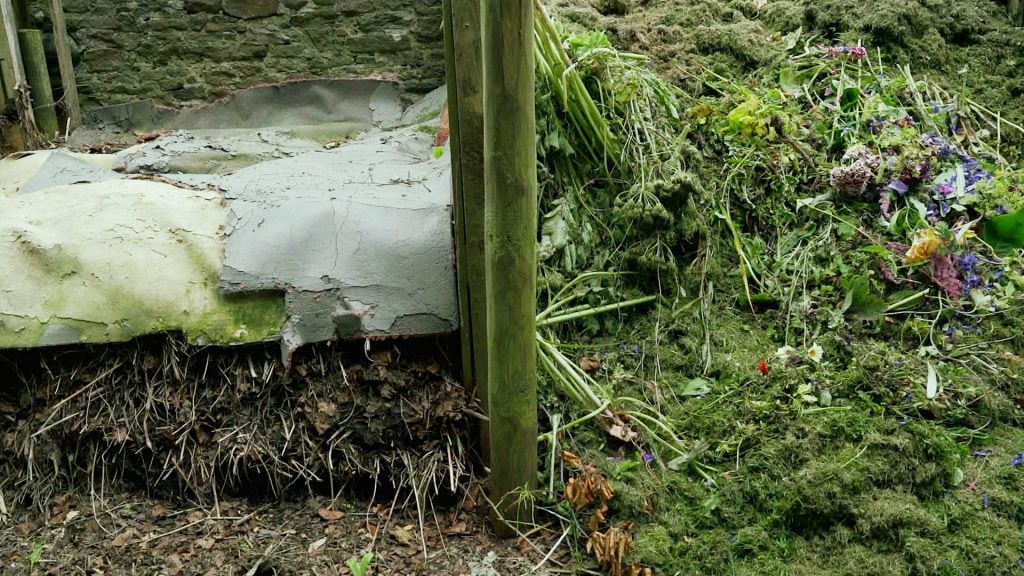
Plantarians, Ellie Kyungran Heo, 2017-2020.
A sharply angled close-up casts the viewer’s gaze into a gravel path diagonally intersected by a long-nosed watering-can advancing at great speed. ‘Aha!’ one thinks, ‘The war on weeds has been lost’, as the invaders push through the gravel, but we are not where we think we are. A sudden cut to a mid-shot of a graveyard shows that this human-watering-can assemblage is only concerned with the cultivated blooms that adorn the plot tended by its owner. Shot in a graveyard in Maastricht, a number of sequences poignantly show how cultivation of flower beds, however miniature, embodies and produces memories allowing their carers to maintain bonds of closeness to deceased loved ones. Another man, looking towards his wife’s grave on which potted plants blossom, converses to the side of the camera. He sniffs a sprig of lavender, laying it on her grave: “so that she can smell it too.” The practices that Kyungran Heo homes in on here could be said ‘to domesticate […] absent presences, and in so doing to seek a comfortable, even if ultimately impossible, alignment between self, past, memory and landscape’.[5] But under Kyungran Heo’s animistic gaze, plants too have agency in caring for both the tended and the neglected plots. As well as by her dynamic camerawork, she implies this by sound: the sound of leaves rustling in the wind intimating a form of transmission conjoining the earth’s multiple vegetal inhabitants. Trees, and plants too, communicate with one another through electrical signals and sounds that have been measured at a frequency of 220 hertz.[6] This underground vibration, inaudible to human ears, is virtually ambient in the full emptiness of Kyungran Heo’s meditative observational gaze.
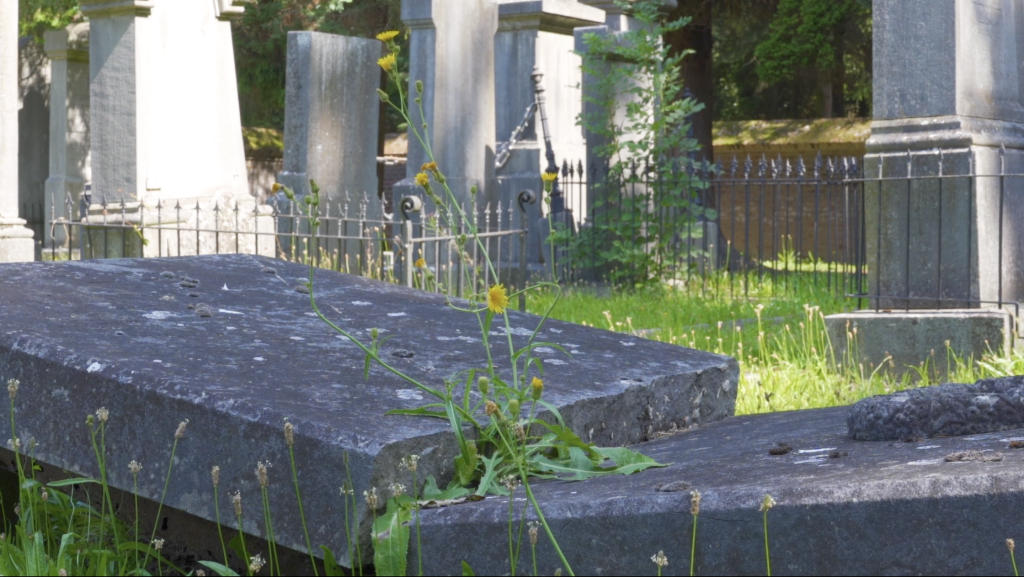
Plantarians, Ellie Kyungran Heo, 2017-2020.
But it’s not all contemplation. The series also comprises of a number of humorous shorts that squarely make associations between plant cultivation and human bodily processes. One of the episode’s intertitles is ‘the garden on your belly’, while in the short More Salad, huh?, 2018, the action of a cutter trimming a flowerbed border is accompanied by a fine hearty belch: a compliment to the chef, gratitude for a meal, or bad manners, depending on one’s cultural milieu. In Plantarians: Appendix, 2020, a young woman, trapped in a three-sided box that frames the image, attempts to stretch her limbs, her inhibited extensity probing how and why we restrict plants’ movements by potting them.
Unlike the classical and modern philosophers such as Plato and Heidegger, more recent scientific research explores plant movement. Plants move underground, often quite aggressively, and in fact, on land the vegetable kingdom makes up 99 percent of the planet’s biomass.[7] Above the ground there is movement too, not just untrammelled growth towards light sources such as the sun but, as Teresa Castro documents in The Mediated Plant (2019), some plants, e.g. Venus Flytraps, overtly coil and recoil in relation to touch by human and nonhuman others. Castro also documents how towards the end of the nineteenth century, scientists began using ‘motion analysis devices, such as graphic tracing techniques and eventually time-lapse cinematography, in order to demonstrate that apparently inert plants could move, “sleep,” and were sensitive’.[8] While Kyungran Heo’s films are far removed from cinema’s spectacularisation of plant motion, nonetheless, the latter could be said to have readied us for attending to the temporalities of plant being and its world-forming capacities.
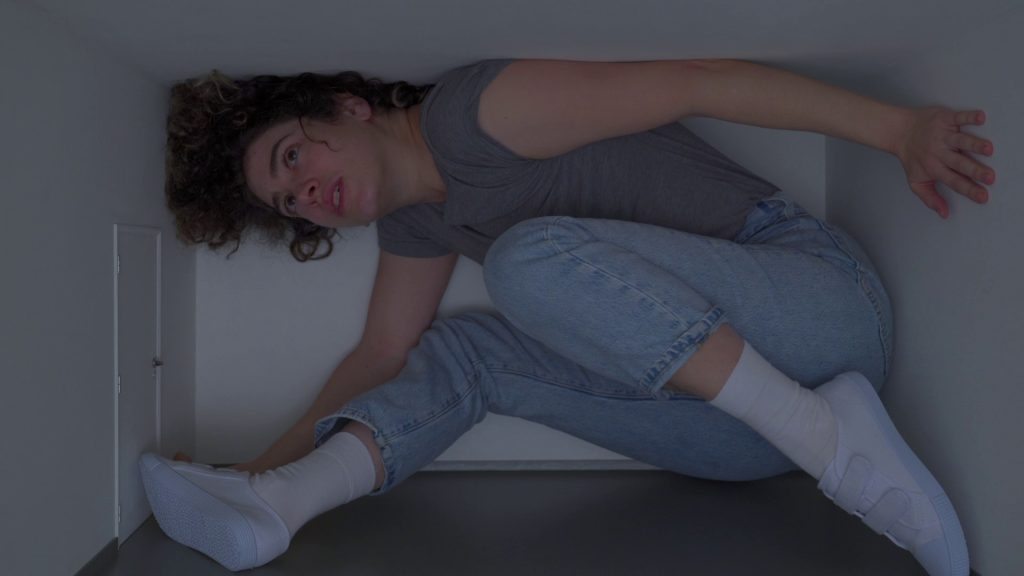
Plantarians: Appendix, Ellie Kyungran Heo, 2020.
For Plato, plants were a passive life–form possessing a third kind of soul, psukhe, characterised by growth, albeit blind and purposeless.[9] Aristotle continued in this vein in his treatise On the Soul (c. 350 BC) but, unlike Plato, he did not scorn plant-life, considering its psukhe as having a capacity for a certain, albeit limited, kind of world-forming.[10] Kyungran Heo is sensitive to this nutritive soul. At the end of the Hospitalfield summer residency during which Plantarians was partly developed participating artists celebrated with a meal. Another pair of hands, this time throwing a bunch of greens – nettles perhaps – into a cauldron of steaming hot water, performs an everyday action, but the precision of the editing and the accompanying smelting sounds, sensitizes its viewer to the impact of leaf meeting heat unbearable to human skin. The scene recalls the 5 minute short, Janchi Guksu (Banquet Noodles), 2016, in which a bunch of anchovies are drained in a sink their mouths wide-open as if caught in mid-flow screams at their future fate -to be devoured for the celebratory dinner whose laughter and din comprises the soundtrack.[11] However, rather than making any moral judgement on the human consumption of plants and fish, Kyungran Heo ponders what it is to eat well – part of which is the sharing of food with others as well as the sharing of how that food is sourced and deposited as waste. As philosopher Jacques Derrida maintains, there is a distinction between assimilating others – whether food or other people – in ways that nourish and in ways that conquer them as trophies.[12] The point is not to become a vegetarian, a vegan or a Jain,[13] but to acknowledge that, while one needs to eat and/or assimilate others in order to live, one also needs to reflect on the situational ethics of these actions. To eat well is to be ecologically mindful of the sacrifices of animal and plant life intrinsic to human food consumption. Static camera shots in Plantarians, for example, one of a dinner plate decorated by plant life – such decoration perhaps historically related to acknowledging the gift of nourishment, or a sublimation of the guilt that can surround eating – give us time to consider the conflicts involved.
Close-ups of the meals’ waste focus on the bouquets of now wilted cut flowers, which, while in one sense an unnecessary plucking, are on the way to becoming another vital form, i.e. compost. The camera attentively stares at a worm, its slow slithering motion, as well as the squelching noises on the soundtrack, intimating another component of the cycles of life. As Donna Haraway puts it, we are all compost:
Critters – human and not – become with each other, compose and decompose each other, in every scale and register of time and stuff in sympoietic tangling, in ecological evolutionary developmental earthly worlding and unworlding.[14]
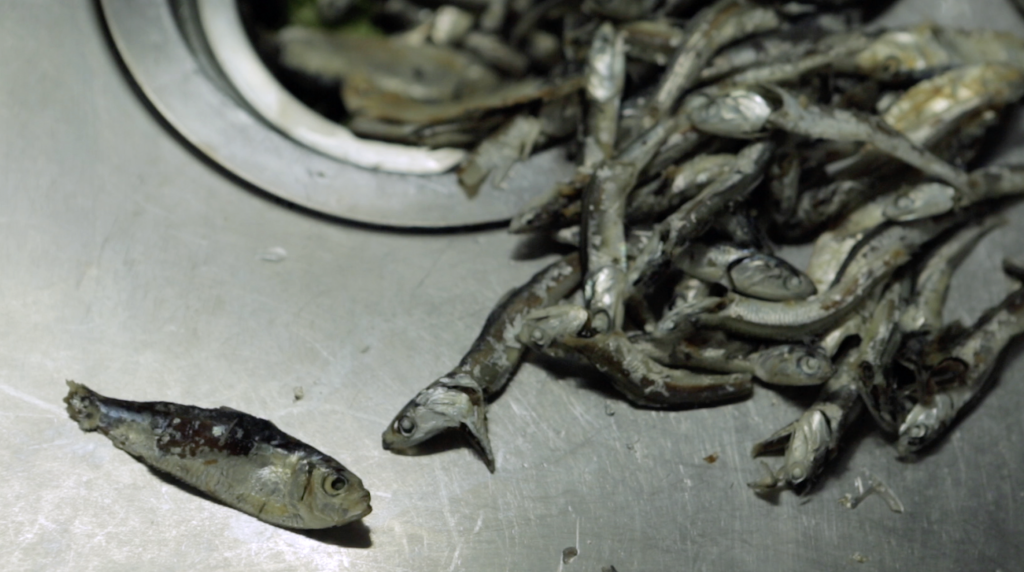
Janchi Guksu (Banquet Noodles), Ellie Kyungran Heo, 2016.
It is tempting to contrast the etiquette and pedagogy of eating well in Plantarians with that in Did you eat rice?, 2017. Shot in Omachi Japan, Did you eat rice?[15] follows the seasonal cycle of rice production on a small farm holding. An experimental documentary, it choreographs static camera shots of the grid-like paddies and dynamic close-ups of mud, stalks, sky and the expressive faces of the scarecrows that oversee the paddies during the heavy downpours that pervade the film’s opening. The wetness is palpable, dense. Backgrounded by mountains, the paddies’ parameters are outlined by trenches that hold flood water, which protects and nourishes the soil. A number of durational long-shots observe the methodical labour of planting, tending to, and harvesting the rice especial to this region. Fascinated by the dexterity and skill of labour, Kyungran Heo’s signature style homes in on the farmers’ hands as they erect the wooden racks on which to dry the harvested crop. But this is no romantic agricultural idyll. Although the plough and thresher are a far cry from the hyperindustrial machinery used in intensive farming, the film generates a creeping awareness of the dependence on fossil fuels that even this mostly traditional rice farm relies on. While action has been taken in Japan to offset the planetary impact of intensive rice farming, for example, some reduction of use of pesticides and an extremely small percentage shift to organic production – 0.12% as of 2017,[16] Did You Eat Rice? oscillates between environmental disturbance and a taking care of that impact. Perhaps we can muse with philosopher Bernard Stiegler that:
agriculture is a care taken of the world: it is a therapeutic. […] The farmer […] cultivates an art of working the land that is also a violence done to the land, to the earth. This violence must be tempered and sublimated into a taking care of this earth. The farmer causes nature to suffer but, in making nature suffer, he makes of it a culture – insofar, however, as he worships it.[17]
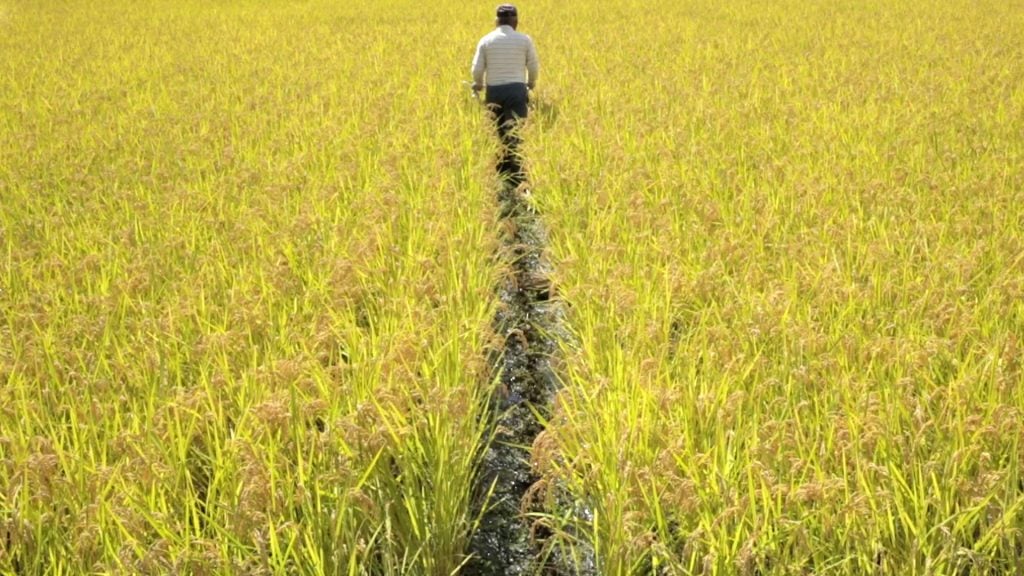
Did You Eat Rice?, Ellie Kyungran Heo, 2017
The film does not mention the term, but its images are suggestive of the Japanese principle of Satoyama, i.e. ‘traditional peasant landscapes, combining rice agriculture and water management with woodlands’.[18] Recently there has been an increased social–ecological restoration of Satoyama landscapes in Japan.[19] The film’s astoundingly beautiful close-ups of sunlight glinting on the muddy water surrounding the felled rice stalks intimate how this farmer attends to such eco-systems. In intensive farming, the stalks are burnt and other crops such as barley planted on the exhausted soil, but here the paddies are left fallow, the wet muddy conditions becoming a habitat for rare grasshoppers, dragonflies, and frogs which in turn enrich the soil for the next rice season. Though absent, their presence is inferred by the camera’s uptake of the view from below, the field of vision becoming diffuse and without contour, as if it were an insect in the undergrowth.
In rural biocultural landscapes deploying the Satoyama principle, humans are collaborators with nature in enabling an eco-system to adapt to moderate levels of disturbance. Combined with this
satoyama movements attempt to recover the lost sociality of community life. They design activities to bring together elders, young people, and children, combining education and community building with work and pleasure.[20]
A group of school children trail into the fields. Every year the children come to learn by doing how rice is produced. They help with the harvest: chopping and tying the stalks, hanging them out to dry, the arrangement of which comprise some of the film’s most striking near abstract depth-of-field shots comprised of striated texture and colour. A pragmatic aesthetics, knowing through doing how food is grown and processed is part of a taking care of the inevitable human impact on the earth.

Did You Eat Rice?, Ellie Kyungran Heo, 2017
Eating well could also be said to have a quality of worship in Did You Eat Rice? Two moments stand out. The camera closely attends to the farmer being handed a bowl of rice, the first from this harvest. He raises the bowl saying “Itadakimisu” a Japanese expression that acknowledges the sacrifice of, in this case, the plants that make up the meal. The expression adds to the immanent transcendence of the moment as the cabin’s dim glow of light, and the camera apparatus, illuminate the sticky rice. He bows down, smiling, and begins to eat. The school children also return to celebrate by eating the rice they helped produce. Earlier, Kyungran Heo’s camera had been entranced by one of the school children, a girl who, while incorporated by her peers and teachers into the harvesting activities, was also slightly outside of them. Kyungran Heo, an outsider to Japan, focuses on and follows the girl’s movements and gestures as she clamours in the mud, screeching rather than chit-chatting like her peers. Yet she quietly caresses the felled rice, her affinity with their fate – to be violently separated from the grains – giving her an air of gentle sadness.
Later, as she eats her rice ball apart from her peers, the camera attends to her in an almost unbearable proximity. The shot is still and goes on for a long time, the girl giving her body to the camera without any semblance of performance. While she is clearly aware of and looking at the filmmaker and thereby the viewer, it is unclear whether she is aware of the camera as an instrument that will project her ‘soul’ for an external anonymous audience. What is the ethics of looking here? Should I look away? Am I betraying her vulnerability by continuing to stare? But the tables are turned slightly when she raises her hand and makes the peace gesture, as if permitting the look as a welcome being-with another in a reciprocal, albeit, asymmetrical togetherness.[21]
The question of whether looking is a further act of violence towards vulnerable subjects or whether it can generate a compassion that ‘stays with the trouble’ also arises in Island, 2015, which is shot on the South Korean island of Mara. Comprising an area of 0.3 km2 and home to about 90 residents, the island, renowned for its volcanic layers of rock, is a popular tourist day trip. But Kyungran Heo’s focus is a stray dog, a white hound who randomly enters into and out of the frame and the other events that occur in the film: various groupings of tourists taking photographs; and a resident who drives about in an open-topped vehicle with her ‘family’ of dogs, often to tend the grave of one of her ‘babies’ buried near the Catholic church. While a main protagonist, the white hound sometimes seems like an otherworldly spirit, a phantom whose presence is largely overlooked, and it is, in fact, the soundtrack that asserts his agency within his environment, i.e., the gut-wrenching yelping that ensues from off-screen attacks by and of the other dogs. Careful not to show the animal violence, its aftermath is shown in a close-up of white animal hair filling the screen. A mottled bloody wound gapes like a portal between a before and an after: a before when the dog could defend and attack; an after when the rainy season arrives, tourists are few, food is scarcer, and his ribs protrude. Wandering distractedly on the island’s viewing bandstand, a nuclear family comment on the starving dog’s bandaged leg, which both infers yet another fight, or accident, and the fact somebody took care to wrap the wound in gauze, now blood-stained and water-logged. He limps off-screen. The family are indifferent. What can they do? What did the filmmaker behind the camera do? What do we do with our look at the animal? While one cannot but be moved with compassion, pity would subject him to being a victim rather than acknowledging his autonomous existence, albeit a cruel one. By contrast, the film’s impassive gaze retains his independence from human emotional assimilation, while, at the same time, it intimately touches his suffering in a way that might alert to us to our own cruelty.
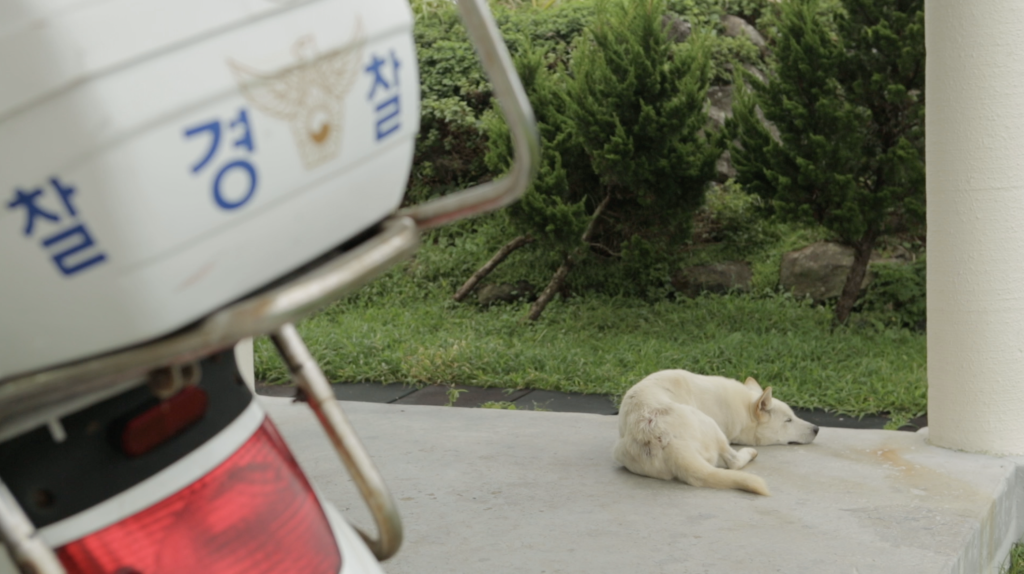
Island, Ellie Kyungran Heo, 2015
On the rare occasions when there is human speech in Kyungran Heo’s films, it is generally men who speak: previously a prison warden, the official who administers the comings and goings of the island ferry, is haunted by the memory of witnessing a former inmate’s suicide; the slightly inebriated monk who resides in the island’s Buddhist Temple eats noisily while addressing the camera/filmmaker/viewer with the question: “Why were you born a human?” Bringing these oblique allusions to death and life into a constellation with the encounter with the stray, Kyungran Heo participates in, and invites her viewers to participate in, a filmic assemblage whose ‘soul’ cannot be separated from the unfolding of the existences that coalesce on its plane. There is violence, but it is part of a series of agential differences rather than an object of standalone perpetration. Sensitive to the intersecting harmonies and disturbances of interspecies world-forming, Kyungran Heo’s films (at)tend to the caring of harm as good-enough, but not perfect, ways of coexistence. There is some solace in this tender vision.
[1] Filmic assemblages can be thought of as an amalgamation of all the actants that co-constitute the materiality and resonance of a film. The myriad human and non-human actants that make up film assemblages can be listed as ‘lights, camera, editing machines, actors, editors, filmmakers, and directors, to identify just a few’ (Bolt: 2013, p.5). See Carnal Knowledge: Towards a ‘New Materialism’ Through the Arts, Barrett and Bolt (eds), (London: I.B. Tauris, 2013). Note that viewers and the entities to-be-viewed are also part of this composition.
[2] Martin Heidegger cited in Jeffrey T. Nealon, Plant Theory: Biopower and Vegetable Life, (Stanford University Press: 2016), p. 39. Since Heidegger made this philosophical pronouncement in 1930, there have been numerous critiques of his hierarchical taking of Man as the measure of all living things.
[3] The Mushroom at the End of the World: On the Possibility of Life in Capitalist Ruins, (Princeton University Press: 2015), p.5.
[4] Mabel McKay, a Powo healer, cited by Starhawk in María Puig de la Bellacasa, Matters of Care: Speculative Ethics in More Than Human Worlds, (University of Minnesota Press: 2019), p. 148.
[5] Franklin Ginn writes about such practices in relation to gardens in Britain, but it seems apropos to this Dutch setting too. See his ‘Death, absence and afterlife in the garden’, Cultural Geographies, 21.2, 2014, pp. 229-245. First published online in 2013: https://journals.sagepub.com/doi/10.1177/1474474013483220, accessed 2 September 2016.
[6] See Richard Grant, ‘Do Trees Talk to Each Other?’, https://www.smithsonianmag.com/science-nature/the-whispering-trees-180968084/, accessed 24 October 2021.
[7] Nealon, p. 109.
[8] Castro, ‘The Mediated Plant’, e-flux, #102, September 2019, https://www.e-flux.com/journal/102/283819/the-mediated-plant/, accessed 19 September 2021.
[9] Nealon, p. 31.
[10] Ibid., p. 37.
[11] ‘Janchi guksu’ is a Korean noodle dish consisting of wheat flour noodles in a light anchovy stock, typically topped with thin strips of beef, eggs, and vegetables. The dish is traditionally eaten throughout Korea on special occasions such as weddings and birthday parties.
[12] See Kelly Oliver, ‘Derrida and Eating’, Encyclopedia of Food and Agricultural Ethics, Thompson P.B., Kaplan D.M. (eds), (Springer, Dordrecht, 2014), pp.459-465.
[13] Jainism, a Hindi religion advocating ahimsa, i.e. non-violence, forbids the eating of root vegetables as well as animals.
[14] Staying With the Trouble, (Duke University Press: 2016), p. 97.
[15] The most overt pedagogical sequence in Plantarians is when Central Park forager turned tour guide and educator, Steve Brill, gives an eccentric talk on plant and animal life, while the camera tries to keep up with, and thence mirrors, his frenetic energy. In 1994, Brill published Identifying and Harvesting Edible and Medicinal Plants in Wild (and Not So Wild) Places.
[16] See the website https://www.jetro.go.jp/en/trends/foods/ingredients/rice.html, accessed 3 October 2021.
[17] ‘Taking Care’, 2006, Trans. by Daniel Ross, https://www.academia.edu/12692394/Bernard_Stiegler_Taking_Care_2006_, accessed 27 September 2021.
[18] Tsing, p. 152.
[19] See Social-Ecological Restoration in Paddy-Dominated Landscapes, Nisikawa Usio and Tadashi Miyashita (eds), (Springer, Japan: 2014).
[20] Tsing, p. 262.
[21] Kyungran Heo has been inspired by the ethics of looking in Michael Haneke’s films. Email to author, dated 6 October 2021. Although different in genre and philosophical approach, I am also reminded of the cinema of Robert Bresson, his close-up focus on gesture and his affinity with vulnerable outsiders.
Maria Walsh is author of Therapeutic Aesthetics: Performative Encounters in Moving Image Artworks, (Bloomsbury, 2020). She is Reader in Artists’ Moving Image at Chelsea College of Arts and Reviews Editor of MIRAJ (Moving Image Review and Art Journal).
This essay is available in Korean translation by Jaeyong Park.
Read the translation here: 엘리 허경란 영화에서의 다정한 먹기 그리고 주의 기울이기/이바지하기
Co-commissioned by the London Korean Film Festival and LUX as part of Ellie Kyungran Heo’s solo exhibition, Plantarians (2017-2020).


